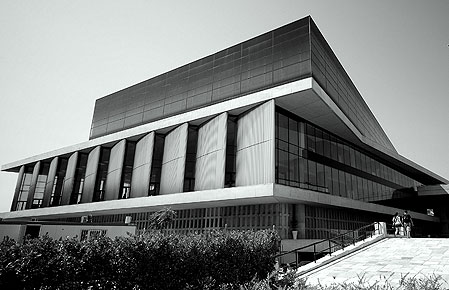Although boasting a wide range of exhibits, including ceramics, bronzes and coins, the New Acropolis Museum, scheduled to open to the public June 22, is principally a museum of sculpture.

Many of the sculptures are architectural pieces, originally adorning the monuments of the Acropolis, seen under all variations of daylight. Appreciation of these variations in the sculptures is assured for the visitor through the extensive use of glass in the Museum’s design. The emphasis on natural light is reflected in all the Museum’s galleries. Light penetrates down through the glass floored atrium of the Parthenon Gallery, onto the glass floor of the ground level galleries – allowing natural light to gently touch the archaeological excavation below. Natural light enters the archaeological excavation at its perimeter through the opening at the perimeter of the excavation and through the perforated walls of claustra. According to the Architect Bernard Tschumi, "if architecture can be described as the materialization of concepts, the building is about the clarity of an exhibition route expressed through three materials, marble, concrete and glass. Within the unusual constraints of the site, the project ought to appear effortless and almost undesigned: a base of pilotis above the ruins, a middle section containing the main galleries, and a glass top at the summit containing the Parthenon frieze. The goal of this orchestrated simplicity is to focus the viewers' emotions and intellect on extraordinary works of art".
The new museum is expected to increase pressure on the people in charge of the British Museum to finally agree and return to Greece the of unparalled beauty Parthenon Marbles, exracted by Lord Elgin, after bribing the Ottoman authorities, in order to bring them to England, causing unreversed damage to many of them in the process. After Grece officially requested their return in the ‘80s, British would base their refusal on the lack of an appropriate place in Athens to keep and display them. Now, as the British Committee for the Reunification of the Parthenon Marbles says: "The Greeks have long wanted their Marbles back, but the building of the new Acropolis Museum finally gives them the physical authority to buttress an argument that has too often relied on shrill sentimentalism and unsubtle jingoism. The museum is a provocation, an enticement, a tease. Bernard Tschumi [the Swiss architect] has done everything other than daub slogans on the exterior walls to say to the world at large: 'The Parthenon Marbles belong here, next to the building from which they were taken.'"
 The construction of the New Acropolis Museum – for which two historic buildings had to be demolished - to house the entire collection of surviving antiquities from the Acropolis has been Greece’s objective for more than three decades. Almost as soon as it was first built in the 19th century, the old museum became too small for the wealth of antiquities recovered on the Acropolis.
The construction of the New Acropolis Museum – for which two historic buildings had to be demolished - to house the entire collection of surviving antiquities from the Acropolis has been Greece’s objective for more than three decades. Almost as soon as it was first built in the 19th century, the old museum became too small for the wealth of antiquities recovered on the Acropolis.
As a result, many of the finds were displayed in various Athenian museums or simply left in storage. The old museum’s limitations, the extraordinary significance of the finds and the effort to reunify all the surviving pieces of the Parthenon’s unique architectural sculptures, made the construction of a new museum imperative.
For the first time since the completion of archaeological excavations, all significant findings from the Acropolis are consolidated in one Museum, telling the complete story of life on the Athenian Acropolis and its surrounds.
From prehistory through to the highpoint of the Classical Period and the Parthenon, to the artifacts created during the Roman Period and late Antiquity – rich collections will provide visitors with a comprehensive picture of the human presence on the Acropolis. The extensive remains of the ancient Athenian city revealed on the Museum’s site by the pre-construction archaeological excavations, will also grace the Museum’s exhibition program.
For more information on the New Acropolis Museum the website is www.newacropolismuseum.gr
Information for this article was taken from the American Friends of the New Acropolis Museum website www.afnam.org







